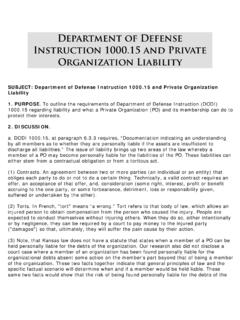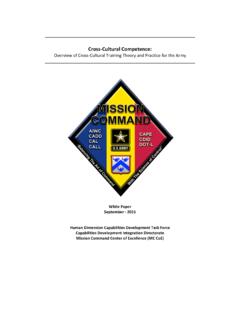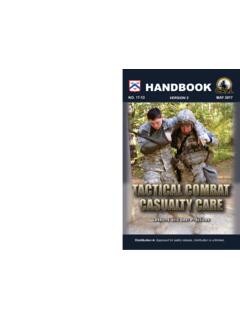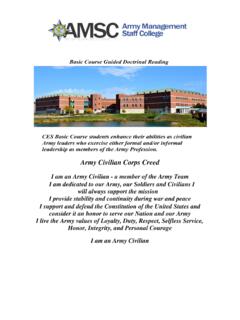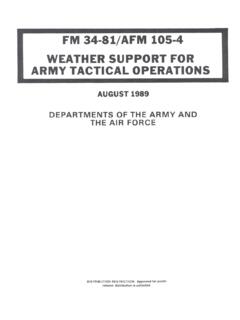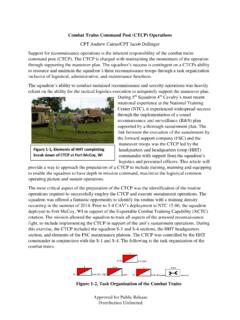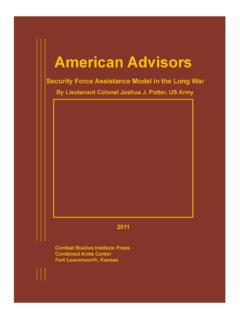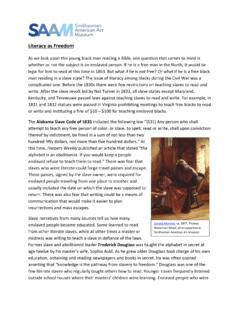Transcription of Strategic Leadership: A ... - United States Army
1 Strategic Leadership: A Recommendation for Identifying and Developing the United States army s Future Strategic Leaders Major Larry Burris The views, opinions, and ideas outlined in this paper are purely those of the author and do not in any way represent the views and positions of the United States Government, the Department of Defense, or the Department of the army . The content in this paper is solely attributable to the author. 2 Furthermore, in contrast to World War I when the War College closed its doors from 1917 to 1919, and again in World War II when General Marshall closed the army War College in 1940 and they did not reopen again until 1950, we have maintained and grown our leader education program.
2 We remain committed to it. - General Peter J. Schoomaker Chief of Staff, army Remarks to the 2005 Association of the United States army Eisenhower Luncheon Executive Summary The army s current model for identifying and developing its Strategic leaders occurs far too late in an officer s career progression, thus limiting the benefit the officer, the army , the nation and most importantly the soldiers receive in return. The army can improve on its Strategic leader development by implementing a program which identifies a pool of officer candidates earlier in their careers with the requisite performance, skills and cognitive capabilities to deal with the complexities of future Strategic decision making.
3 In order to better prepare the next generation of future army Strategic leaders, the army must be able to identify a pool of officers early in their careers who demonstrate the desired characteristics and potential for continued service as future Strategic military leaders, given that the army s current best predictor of future performance is current performance. The United States army War College defines a Strategic leader as a leader who is an expert, not only in his own domain of war fighting and leading large military organizations, but also in the bureaucratic and political environment of the nation s decision making process.
4 This domain includes a detailed knowledge of, as well as the interrelationship among economics, geopolitics, military and The Strategic leader understands Strategic art, which is the skillful formulation, coordination, and application of ends, ways, and means to promote and defend the national The Strategic leader provides the organization s Strategic vision and focus, inspires others to think and act, and coordinates ends, ways, and This paper proposes three approaches to the early identification and development of the army s future Strategic leaders. The approaches range from the very broad to the very selective.
5 The approaches 1 United States army War College, Department of Command, Leadership and Management, Strategic Leadership Primer, 2nd Edition, Carlisle Barracks, Pennsylvania, 2004, pg iii. 2 United States army War College, Department of Command, Leadership and Management, Strategic Leadership Primer, 2nd Edition, Carlisle Barracks, Pennsylvania, 2004, pg 1. 3 United States army War College, Department of Command, Leadership and Management, Strategic Leadership Primer, 2nd Edition, Carlisle Barracks, Pennsylvania, 2004, pg 2. 3 are: 1) the mass Intermediate Level Education Strategic leader education approach, 2) the implementation of the Junior Officer Strategic Leader Development Program and 3) the army Strategic Leader Development Program approach.
6 The six criteria used to evaluate the three approaches, and their associated weights are: 1) cultural acceptability (10%), 2) peer acceptability (5%), 3) ease of implementation (5%), 4) cost (10%), 5) provides exposure to Strategic leaders and decision makers (30%), and 6) percentage of target population who become Strategic leaders (40%). In comparing the three approaches against the criteria and weights, the second approach, the Junior Officer Strategic Leader Development Program is the clear choice. The Junior Officer Strategic Leader Development Program is a four - year program which focuses on only those officers with the most potential for service and success as future army Strategic leaders.
7 army Strategic leaders are defined as those colonels and general officers who lead in the Strategic environment and those subordinate officers who affect the decisions made by those holding Strategic decision making positions. During the first year of the program, the officer will be required to attend Intermediate Level Education at either a sister service or joint staff college in order to focus on interagency, international, joint, and combined warfare - sharpening the tool sets needed for war in the 21st century. The second year of the program is spent in graduate school resulting in a master s level degree in strategy, national security studies or foreign affairs from a highly reputable university such as Georgetown University or the George Washington University, due to close proximity and access to the nation s Strategic leaders.
8 The candidate s capstone or thesis paper will address a Strategic issue currently being faced by one of the services, combatant commands or the national command authority. The third year of the program consists of a one year tour of duty in an executive office of the joint, OSD or army staff where the candidate could observe senior military Strategic officers operate and make decisions at the highest Strategic level. This year would provide an appreciation of the Strategic environment, specifically the VUCA (volatile, uncertain, complex and ambiguous) environment that exists at the Strategic level and the recognition that problems at the Strategic level are complex and difficult.
9 The final year of the program consists of a one year tour of duty in the executive office of another government agency such as the Department of State, Federal Bureau of Investigation, Department of Justice or the 4 Central Intelligence Agency. Through exposing officers with high potential to the executive leadership of other government agencies, they will better be prepared to deal with other branches and organizations of the government when they are Strategic leaders and have to make decisions impacting other parts of the government and the nation as a whole. By implementing the Junior Officer Strategic Leader Development Program to identify and develop its future Strategic leaders, the United States army ensures that its bench is always full of officers who have been appropriately selected, trained and developed to fill its future Strategic leader requirements.
10 It will also be able to reduce the number of developing jobs required of its Strategic leaders, enabling earlier assignment to positions of greater responsibility and influence and therefore longer utilization. 5 When we prepare our Soldiers for combat, we need to facilitate a third American trait: a culture of innovation. As leaders, we shape behavior. We must continue to challenge old ways of thinking and remove obstacles to innovation. - General Peter J. Schoomaker Chief of Staff, army Introduction The War on Terror is a different kind of war. Lessons learned in combat have resulted in many leadership lessons learned and changes being implemented at the lowest levels of military leadership education, to include revision of basic training for enlisted soldiers, changes in programs of instruction for non commissioned officer education programs, and the implementation of the Basic Officer Leadership Course for newly commissioned officers.
